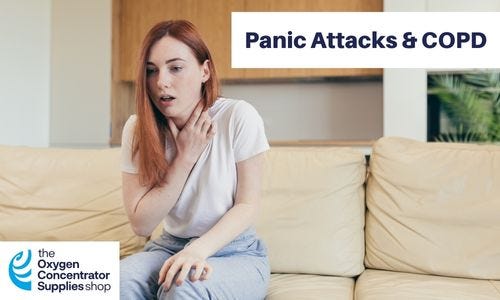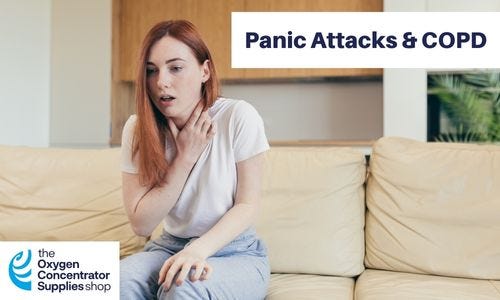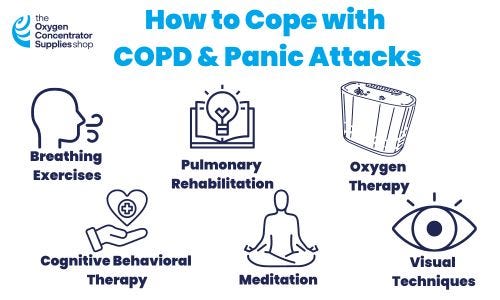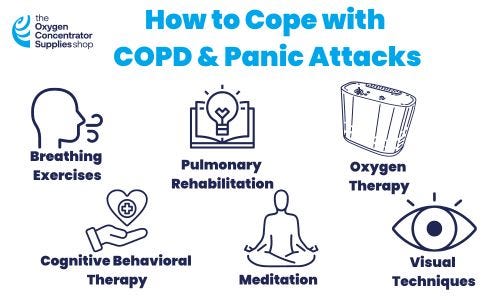Some of the common side effects of COPD are sensations that you are losing breath, shortness of breath, or the feeling that you cannot breathe at all. While not life-threatening, these side effects can understandably trigger a belief that you are dying or suffering a serious medical event. But in fact, these are just panic attacks.


What is COPD?
COPD or chronic obstructive pulmonary disease is a group of diseases that causes blockages to the airway due to inflammation in the lungs. COPD includes respiratory illnesses such as emphysema and chronic bronchitis. COPD progressively gets worse over time but can be managed with proper treatment and lifestyle changes.
What are the Symptoms and Causes of COPD?
Symptoms of COPD are caused by inflammation in the lungs, which causes a reduction in healthy breathing. Symptoms include:
- Shortness of breath, especially when one is physically active
- Tightness in the chest
- Wheezing
- Susceptibility to respiratory infections
- A chronic productive cough
- Swelling in ankles, feet, and legs
- Fatigue
What are Panic Attacks?
Panic attacks are psychological responses to stress and anxiety that can also appear as physical symptoms. Panic attacks can occur unexpectedly and may feel like an intense medical incident, even though they are purely psychological. Panic attacks can happen to anyone but can occur often to individuals who suffer from anxiety disorders.
What are the Symptoms and Causes of Panic Attacks?
Panic attacks can appear as physical and psychological symptoms at the same time. Symptoms include:
- A sense of impending doom
- Feeling out of control
- A sense that you are dying from a sudden medical condition
- Profuse sweating
- Nausea
- Shortness of breath
- Stomach cramps
- Chills or hot flashes
- Tunnel vision
- A feeling of disorientation and detachment from the present moment
Can COPD Cause Panic Attacks?
Patients with COPD may experience panic attacks when they have a breathing-related episode because of their COPD. Once they have shortness of breath, the tightness in the chest can feel as if breathing might cease any moment or that they are having a heart attack.
Patients at the beginning stages of COPD are less experienced with the symptoms and may perceive their breathing episodes with fear and panic, which can only worsen the breathing episode.
How to Cope with COPD and Panic Attacks


The more experienced you become with your COPD breathing episodes the more easily and calmly you can manage any sense of fear or panic.
Breathing Exercises
Breathing exercises can help regulate breathing during an erratic breathing episode. Taking deep and measured breathes helps get normal breathing back on track and can prevent a panic attack.
Cognitive Behavioral Therapy or CBT
Cognitive behavioral therapy is a method for helping individuals become fully aware of the moment they have a panic attack. Understanding that the attack is not life-threatening and turning to mindfulness tools to reduce the attack are part of the benefit of this therapy.
Pulmonary Rehabilitation
Pulmonary rehabilitation helps educate COPD patients on the nature of their illness and how their breathing works with COPD. A better understanding of the disease and their breathing puts them in control of the situation when breathing episodes occur, so they do not escalate into panic attacks.
Medicine for COPD and Panic Attacks
Medications can help reduce the frequency of COPD breathing episodes. In addition, your doctor can prescribe medication to help reduce the anxiety of panic attacks.
If you have COPD, your doctor may also recommend oxygen therapy. Oxygen therapy assists someone with their breathing using supplemental oxygen delivered through a breathing mask or nasal cannula. Those who need oxygen therapy use an oxygen tank or oxygen concentrator to help them receive supplemental air. The difference between the two is that oxygen concentrators use the air around them and convert it to pure oxygen, eliminating the chance of air depletion or having to replace a tank.
Meditation
Meditation is a holistic method for calming yourself and your breathing. Regular meditation can keep your breathing regulated to prevent breathing episodes. Meditation tools can also be the go-to method to help bring yourself down from a panic attack before the attack gets worse.
Visual Techniques
Like meditation, visual techniques can help you get out of the chaotic mindset where panic attacks thrive. Practicing these visualizations can help you imagine a calm, peaceful place and rid your mind of anxious feelings when you feel a panic attack pending.
Conclusion
COPD can be a challenging medical condition, so avoiding panic attacks helps keep your respiratory illness under your control. Knowing the important details of your COPD puts you in the driver’s seat rather than becoming a victim of your own panic. Take control with all the tools available so you can stay healthy with lasting peace of mind. If you are in need of products for oxygen therapy, The Oxygen Concentrator Supplies Shop would be happy to help. We offer hundreds of oxygen therapy products to help those with respiratory conditions continue living their active lifestyles. Please give us a call at 888-941-1688 if you would like to learn more or have any questions.



